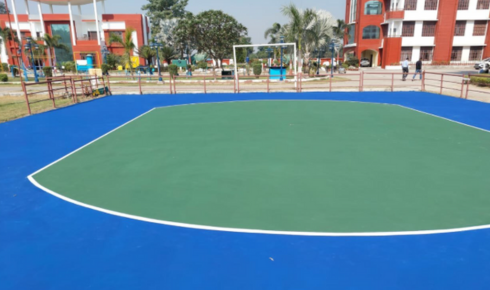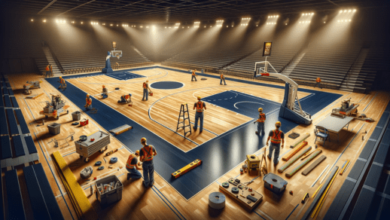Tips for Building Acrylic Skating Rinks in India

Skating is no longer just a recreational activity limited to indoor arenas—it’s now a popular outdoor sport embraced by schools, clubs, and smart city planners across India. Whether it’s roller skating, inline skating, or multi-use sports on skates, the demand for professionally constructed skating rinks is steadily rising. However, the foundation of every successful skating project lies in choosing the right flooring.
A well-built acrylic skating rink offers a smooth, safe, and long-lasting surface that ensures both fun and performance. In this blog, we’ll cover practical tips for planning, designing, and installing high-quality skating rink flooring in India, with a focus on synthetic acrylic systems—currently the most reliable flooring option for outdoor rinks.
Why Acrylic Is Ideal for Outdoor Skating Rinks in India
India’s diverse weather patterns—harsh sun, heavy rains, and fluctuating temperatures—make flooring selection for skating rinks especially important. Materials must handle outdoor conditions without cracking, fading, or becoming unsafe over time.
Acrylic skating rink flooring stands out for several reasons:
- UV-resistant and weatherproof, ideal for Indian climate
- Seamless and smooth surface for fluid skating movement
- Non-slip texture that ensures safety during sharp turns or fast maneuvers
- Customizable in color and cushioning, depending on age group or use
- Low maintenance with minimal surface repairs over years
Synthetic acrylic systems consist of primer, resurfacer, optional cushion layers, and UV-resistant color coats. When installed correctly, they offer unmatched safety and aesthetics—making them perfect for both amateur and competitive skating.
Tip 1: Start with Proper Site Planning and Drainage
Before any flooring can be laid, the ground must be prepared with accuracy and long-term durability in mind. This starts with selecting a level site and ensuring proper drainage systems are integrated into the layout.
Why It Matters:
Water accumulation is the enemy of all sports surfaces. Even the most weather-resistant acrylic systems can suffer if water pools at the surface or seeps into the base. Make sure the base has a slight gradient for runoff and that the concrete is properly compacted and cured.
Also, consider how much sunlight and shade the rink receives—direct sunlight can increase surface temperature. If necessary, plan for shade structures or nearby landscaping to manage heat without affecting play.
Tip 2: Use a High-Quality Concrete Base
The performance of your skating rink flooring is only as good as the base it rests on. Concrete is the most recommended base for acrylic systems due to its durability and strength.
Ensure the base is:
- Levelled precisely to avoid dips or unevenness
- Free from surface cracks before coating begins
- Cured properly to prevent long-term expansion or shrinkage
While asphalt can be used in certain conditions, it is softer than concrete and may be prone to damage over time—especially in high-heat zones. For Indian outdoor rinks, concrete paired with acrylic is the most stable, long-lasting combination.
Tip 3: Choose the Right Acrylic System Configuration
When it comes to synthetic skating rink flooring, one size does not fit all. Your choice of acrylic system depends on the purpose of the rink—whether it’s for beginner training, community fun zones, or semi-professional use.
Standard Acrylic System (5-layer):
- Ideal for low to medium traffic
- Economical choice for societies and schools
- Includes primer, resurfacer, and color coats
Cushioned Acrylic System (8-layer):
- Recommended for heavy use and competitive training
- Adds comfort and reduces joint strain during falls or stunts
- Offers enhanced grip and traction
Both systems support excellent glide, smooth turns, and safe braking, which are essential for skaters of all levels.
Tip 4: Don’t Overlook Line Markings and Zoning
Skating rinks often serve multiple functions—general skating, training drills, or even multi-sport use. Proper line markings help organize the space, guide user flow, and support structured activities.
Acrylic coatings allow you to:
- Use bright, UV-resistant line paint that doesn’t fade
- Customize zones (e.g., warm-up area, performance track)
- Add branding or logos for schools and clubs
This not only enhances the court’s functionality but also boosts its visual appeal. A well-marked rink is safer and more enjoyable for all users.
Tip 5: Plan for Edge Protection and Surrounding Amenities
While the focus is on the skating rink surface, don’t ignore the surroundings. Protective barriers or fencing should be installed around the rink to prevent accidents and control access. Consider adding:
- Safety railings or padded bumpers on the perimeter
- Benches or shade structures for resting
- LED lighting for extended evening play
- Storage zones for skates and equipment
All these elements contribute to a complete skating facility, especially in public parks or school campuses.
Tip 6: Choose a Certified Material Supplier
The difference between a durable, low-maintenance skating rink and one that needs frequent repairs often lies in the quality of materials used. Not all acrylic systems are created equal.
Partner with a supplier that offers:
- Certified and weather-tested acrylic flooring
- Multiple layering system options
- On-site technical support and training
- Customization for color, grip, and finish
- After-sales service and maintenance advice
AQS is one of India’s most reliable names in acrylic skating rink materials. Their synthetic flooring solutions are engineered for Indian conditions and used in schools, parks, townships, and private clubs across the country.
Tip 7: Keep Maintenance Simple but Regular
Acrylic skating rinks are low-maintenance, but consistent upkeep helps extend their life. Here’s what you can do:
- Sweep regularly to remove dust and debris
- Wash with water every few weeks to prevent buildup
- Check for wear in high-traffic zones
- Reapply line paint or color coats every 4–6 years depending on use
Avoid harsh chemicals or pressure washing, which may damage the surface. With minimal care, an acrylic rink can retain its performance for over a decade.
Conclusion
India’s growing interest in roller and inline skating calls for durable, user-friendly, and weather-resistant skating rinks. With the right planning and materials, you can build a facility that offers safety, performance, and longevity.
An acrylic skating rink delivers all of this—combining smooth glide, shock absorption, and vivid colors into one seamless surface. From schools and sports clubs to community parks and private developments, synthetic acrylic flooring is a trusted solution for building world-class rinks.
For developers, architects, and city planners, working with the right materials and partners ensures that every project stays on budget and performs beyond expectations.
AQS offers certified skating rink flooring in India, tailored for all levels of use. Their weatherproof acrylic systems are built for safety, performance, and style—making them the first choice for India’s modern skating infrastructure.

